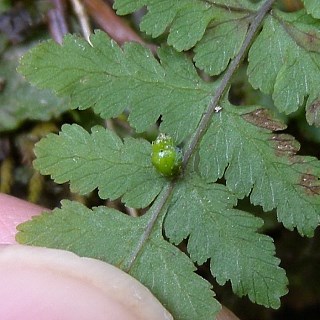Description: This perennial fern forms loose rosettes of ascending to widely spreading compound leaves. These leaves are deciduous. The leaf blades are ½–2' long, while their petioles are 3-6" long. The slender petiole is mostly glabrous and variably colored – usually dark red while young, but becoming pale greenish yellow or pale greenish red with maturity. The leaf blades are light to medium green, bipinnate-pinnatifid in structure and deltoid to lanceolate-deltoid in shape. Each blade consists of about 8-25 pairs of nearly sessile leaflets; the blade is widest at or near the bottom, while its tip is rather long and slender. Each leaflet consists of about 5-15 pairs of subleaflets; the leaflets are lanceolate to lanceolate-deltoid in shape. The pinnatifid subleaflets are shallowly cleft and serrated along their margins; each subleaflet is oblong to lanceolate-oblong in shape. The rachis (or central stalk) of the leaf blade is either hairless or sparsely covered with fine glandular hairs, especially on the underside; like the petiole, its color is variable.

On fertile leaves,
the underside of each subleaflet has 2 rows of small circular sori.
Depending on their maturity, these sori are light green to brown; each
sorus has an indusium with fine glandular hairs. On the underside of
each subleaflet, the lateral veins extend to the sinuses (depressions
between the teeth), rather than to the tips of the teeth. In addition
to the sori, a green bulblet may be produced at the base of some
leaflet undersides. The bulblets are globoid in shape, but cleft at the
top; they eventually become much larger than the sori and drop from the
leaves at maturity (from late summer to early fall). At favorable
locations, these fallen bulblets soon develop into small ferns. The
tiny spores of the sori are released at about the same time of year;
they are distributed by the wind. The root system is fibrous and
rhizomatous. This fern often forms colonies of plants from its bulblets
and rhizomes.
Cultivation:
The preference is light to medium shade, wet to consistently moist
conditions (but always well-drained), and rocky ground (preferably
limestone) with a thin layer of organic material. This fern prefers
sheltered locations with high humidity where there is little
competition from other plants.

Range & Habitat:
The native Bulblet Fern is found primarily in counties along the
Mississippi
and Illinois Rivers; it also occurs in northern Illinois (see Distribution
Map). In these areas, this fern is uncommon to occasional;
elsewhere, it is rare or absent. Habitats include the lower ledges and
crevices of cliffs, rocky ravines, rocky banks of streams, mossy
boulders of rocky woodlands, and mossy stone walls. Usually, the rocky
material of these habitats consists of limestone, although it sometimes
consists of sandstone. In Illinois, the habitats of this fern are
restricted to shady wooded areas that are quite rocky and damp.
Faunal Associations:
Information about floral-faunal relationships for this fern is
currently unavailable.
Photographic Location:
A mossy stone wall at Turkey Run State Park in west-central Indiana.
Comments:
This medium-small fern is unique because of the bulblets that form on
the underside of its leaves. Aside from this unusual method of asexual
reproduction, the Bulblet Fern is similar in appearance to other Cystopteris
spp. (Bladder Ferns) and their hybrids. In general, the
Bulblet Fern can be distinguished from these other ferns as follows: 1)
its compound leaves are widest at or near the base, rather than toward
the middle, 2) the tips of its compound leaves are long and slender,
and 3) the lateral veins of its subleaflets extend to the sinuses
rather than toward the teeth. The Bulblet Fern is one of the parents of
the hybrids Cystopteris × tennesseensis (Tennessee
Fern) and Cystopteris × illinoensis (Illinois
Fragile Fern). When bulblets are present on these hybrid ferns, they
are sparse and misshapen.